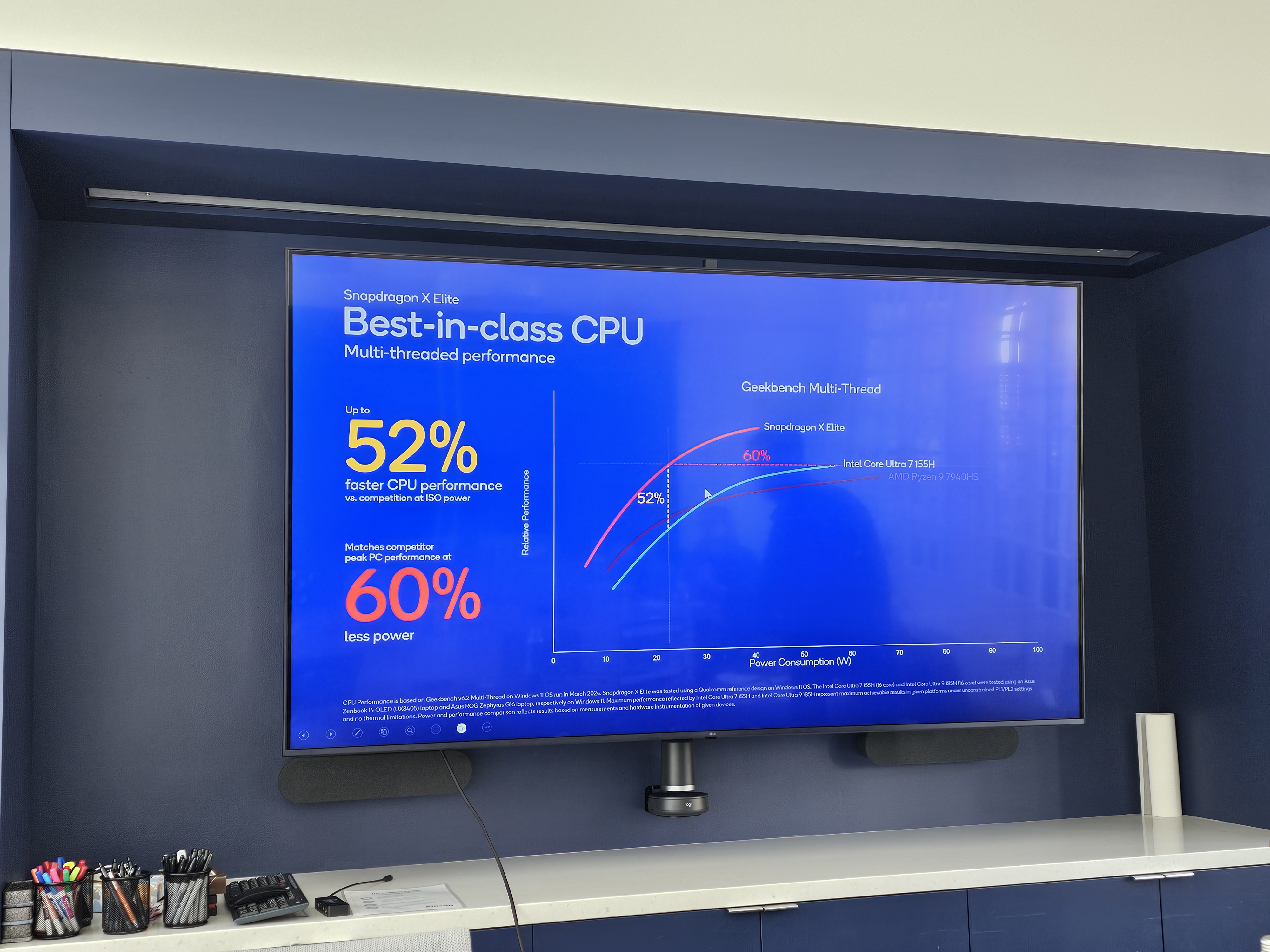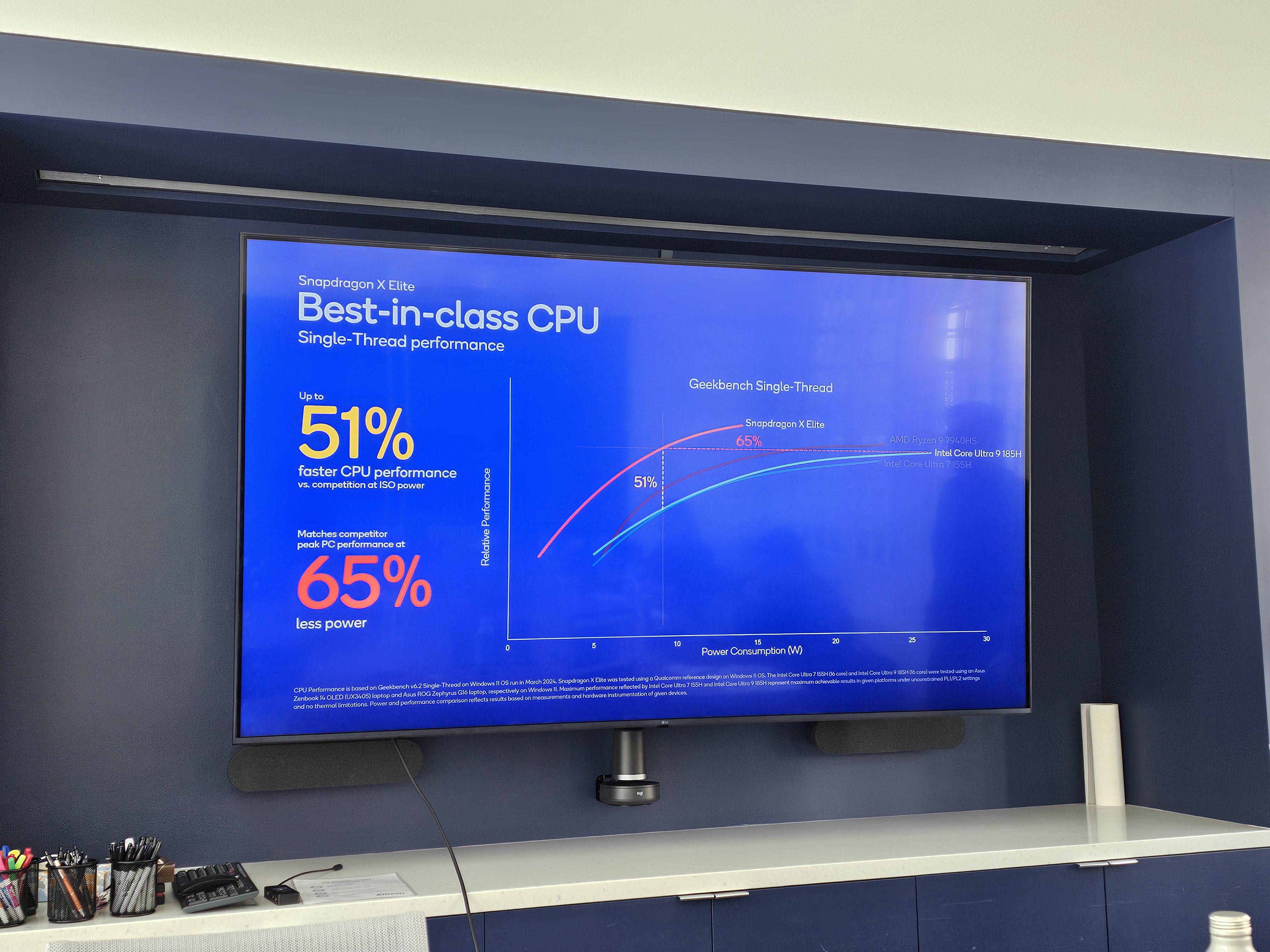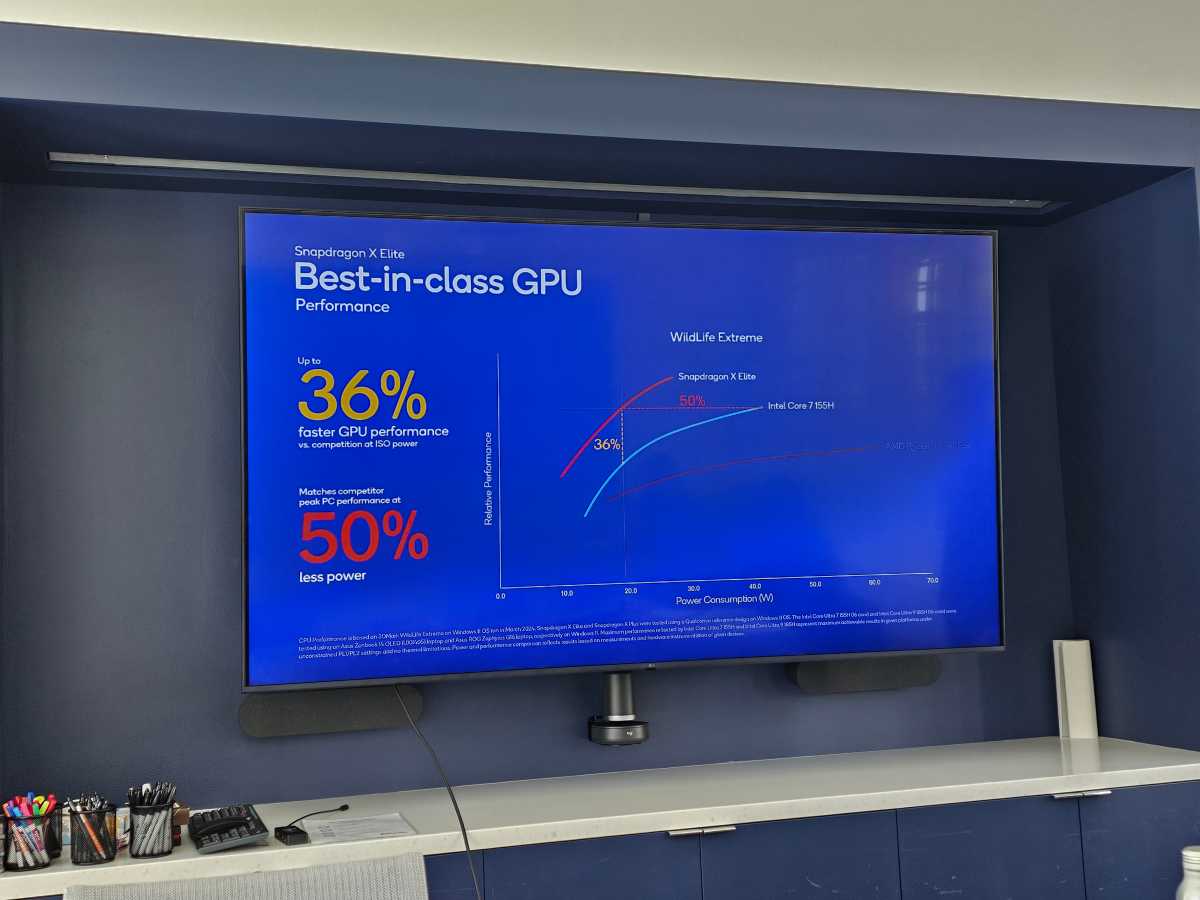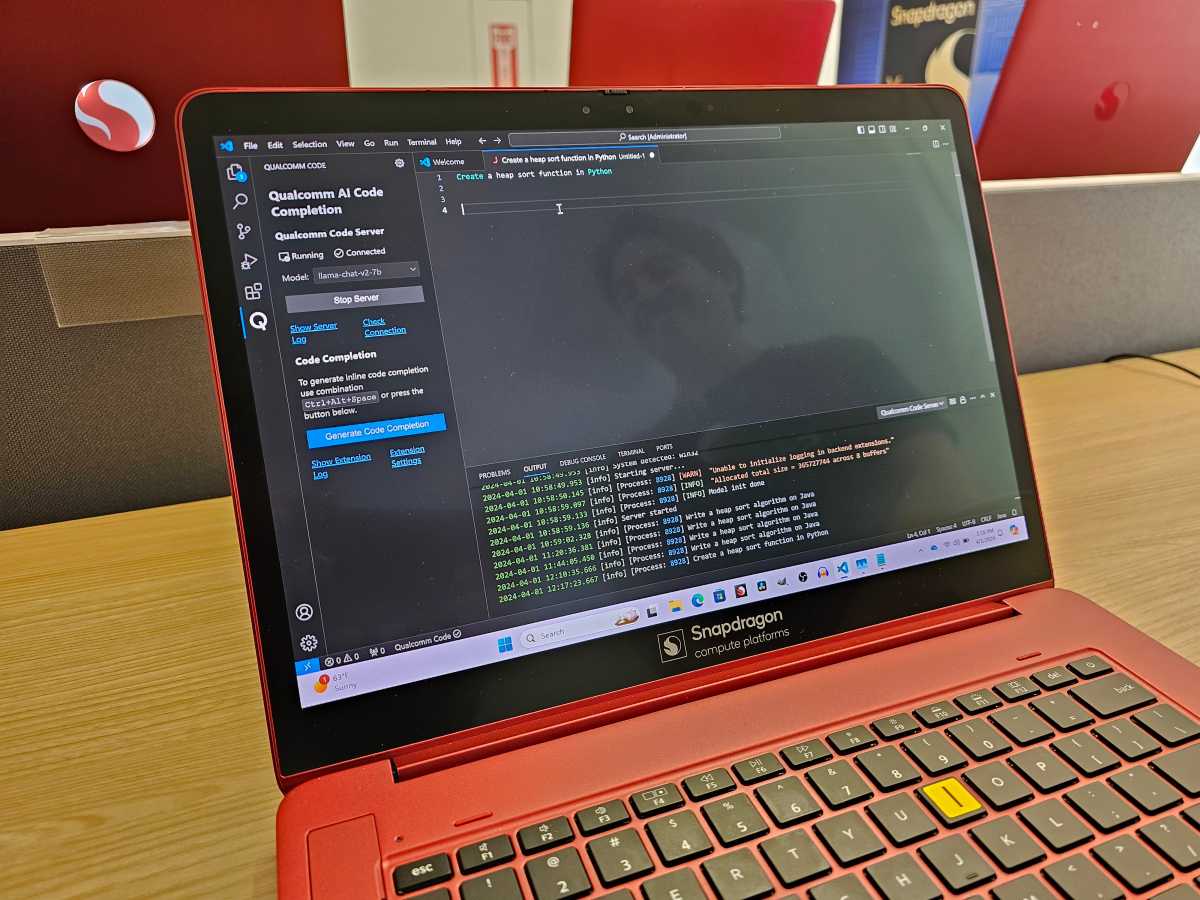When Qualcomm showed off its benchmarks of its new Snapdragon X Elite chips last October, there was one flaw in its argument: Qualcomm was comparing the new Snapdragon platform to Intel’s older 13th-gen Core chips. That’s been fixed. Now Qualcomm says that the Snapdragon X Elite is faster than Intel’s 14th-gen Core Ultra (Meteor Lake) too.
Last October, Qualcomm said that its Snapdragon X Elite could match the performance of the Intel Core i9-13980HX at 70 percent less power. Subsequent hands-off benchmarks of the Snapdragon X Elite appeared to bear that out. But Intel hadn’t launched its Meteor Lake architecture yet to provide a head-to-head comparison. Now it has, and Qualcomm is crowing once again.
In a Monday afternoon briefing, Qualcomm executives provided the same sort of comparisons to Intel’s Core Ultra as it did to Intel’s 13th-gen chips, comparing power and performance. Specifically, Qualcomm called out two chips: the Core Ultra 7 155H (16 cores, which include 6 performance cores and 8 efficiency cores, with a 4.8GHz max turbo speed) and the premium though similar Core Ultra 9 185H (16 cores, which include 6 performance cores and 8 efficiency cores, with a 5.1GHz max turbo speed).
Qualcomm’s Snapdragon X Elite, meanwhile, is made up of 12 Oryon CPU cores, each running at 3.8GHz. Two of those cores can boost up to 4.3GHz. Though the Oryon is based upon the Arm architecture, Qualcomm didn’t adopt the traditional hierarchy of performance and efficiency cores. That approach instead was adopted by Intel, and its Core Ultra (Meteor Lake) processor.
Here’s how Qualcomm sees the two compare. (The Geekbench 6.2 benchmark is being used as a point of comparison. If it matters, Qualcomm used the Asus Zenbook 14 OLED to test the Core Ultra 7 155H and the Asus ROG Zephyrus G16 to test the Core Ultra 9 chip. PCWorld has tested the similar Asus ROG Zephyrus M16.)


Move over, Meteor Lake: Qualcomm’s own tests claim that the Snapdragon X Elite one-ups both the Intel Core Ultra 7 as well as the Ryzen 9 7940HS.
Against the Core Ultra 9 155H Qualcomm sees its Snapdragon X Elite also compare favorably:


Qualcomm’s own benchmarks claim that the Snapdragon X Elite is faster than Intel Core Ultra 9 as well as the Ryzen 9 7940HS.

Mark Hachman / IDG
Mark Hachman / IDG
Mark Hachman / IDG
Qualcomm is also saying that its Oryon core inside the Snapdragon X Elite outperforms Apple’s M3 processor by 22 percent: 15,610 versus 12,154 using Geekbench 6.2.
There is, of course, an omission: Qualcomm isn’t saying how well the Snapdragon X Elite compares to Intel’s 14th-gen Core HX parts. But PCWorld’s tests show that Intel’s 14th-gen Core HX mobile chips don’t exceed the very similar 13th-gen Core HX chips by that much, meaning we probably already have a solid point of comparison here, too.
“This is a phenomenal part, the coverage has been awesome, the reception has been great,” said Nitin Kumar, Qualcomm senior director of product management, said in an interview with PCWorld. “We’re very excited about what we announced and where we are headed.”

Local LLMs running on the NPU will be invaluable for working on flights, Qualcomm executives said.
Local LLMs running on the NPU will be invaluable for working on flights, Qualcomm executives said.
Mark Hachman / IDG
Local LLMs running on the NPU will be invaluable for working on flights, Qualcomm executives said.
Mark Hachman / IDG
Mark Hachman / IDG
Qualcomm executives have still not nailed down the exact battery life of a Snapdragon X Elite platform, which is affected by the battery size, workloads, and other factors. But “multiday” battery life is possible, executives said. Just using a Snapdragon X Elite chip, versus the competing Intel processor, could increase the battery life by 40 percent.
Qualcomm also continued to show off more and more applications that will run natively on the Arm processor used by the Snapdragon chips. Even if they do have to be emulated, Qualcomm executives believe that the performance of the chip will elevate application performance. “Even apps that are not native, but are running in emulation mode, emulation performance is vastly improved,” Kumar said.
We won’t know how Qualcomm’s Snapdragon X Elite actually performs until laptops using it enter our labs. A grand total of nine PC makers have signed on to use Qualcomm’s new Snapdragon X Elite chip — which, at least on paper, continues to impress.
CPUs and Processors
Last October, Qualcomm said that its Snapdragon X Elite could match the performance of the Intel Core i9-13980HX at 70 percent less power. Subsequent hands-off benchmarks of the Snapdragon X Elite appeared to bear that out. But Intel hadn’t launched its Meteor Lake architecture yet to provide a head-to-head comparison. Now it has, and Qualcomm is crowing once again.
In a Monday afternoon briefing, Qualcomm executives provided the same sort of comparisons to Intel’s Core Ultra as it did to Intel’s 13th-gen chips, comparing power and performance. Specifically, Qualcomm called out two chips: the Core Ultra 7 155H (16 cores, which include 6 performance cores and 8 efficiency cores, with a 4.8GHz max turbo speed) and the premium though similar Core Ultra 9 185H (16 cores, which include 6 performance cores and 8 efficiency cores, with a 5.1GHz max turbo speed).
Qualcomm’s Snapdragon X Elite, meanwhile, is made up of 12 Oryon CPU cores, each running at 3.8GHz. Two of those cores can boost up to 4.3GHz. Though the Oryon is based upon the Arm architecture, Qualcomm didn’t adopt the traditional hierarchy of performance and efficiency cores. That approach instead was adopted by Intel, and its Core Ultra (Meteor Lake) processor.
Here’s how Qualcomm sees the two compare. (The Geekbench 6.2 benchmark is being used as a point of comparison. If it matters, Qualcomm used the Asus Zenbook 14 OLED to test the Core Ultra 7 155H and the Asus ROG Zephyrus G16 to test the Core Ultra 9 chip. PCWorld has tested the similar Asus ROG Zephyrus M16.)


Move over, Meteor Lake: Qualcomm’s own tests claim that the Snapdragon X Elite one-ups both the Intel Core Ultra 7 as well as the Ryzen 9 7940HS.
- In single-threaded performance, Qualcomm says that the Snapdragon X Elite is 54 percent faster than the Core Ultra 7 155H at the same power, or, when performance is equalized, consumes 65 percent less power.
- In multi-threaded performance, the Snapdragon X Elite is 52 percent faster than the Core Ultra 7 155H at the same power, or, when performance is equalized, consumes 60 percent less power.
Against the Core Ultra 9 155H Qualcomm sees its Snapdragon X Elite also compare favorably:


Qualcomm’s own benchmarks claim that the Snapdragon X Elite is faster than Intel Core Ultra 9 as well as the Ryzen 9 7940HS.
- In single-threaded applications at the same power, Qualcomm says that the Snapdragon X Elite is 51 percent faster than the Core Ultra 9 155H, consuming 65 percent less power if the performance is equalized.
- In multi-threaded applications at the same power, the Snapdragon X Elite is 41 percent faster than the Core Ultra 9 155H, consuming 58 percent less power if the performance is equalized.
- In graphics, the Snapdragon X Elite is 36 percent faster using the UL 3DMark Wild Life Extreme benchmark than the Core Ultra 9 155H at the same power, and consumes 50 percent less power if the performance is normalized.

Mark Hachman / IDG
Mark Hachman / IDG
Mark Hachman / IDG
Qualcomm is also saying that its Oryon core inside the Snapdragon X Elite outperforms Apple’s M3 processor by 22 percent: 15,610 versus 12,154 using Geekbench 6.2.
There is, of course, an omission: Qualcomm isn’t saying how well the Snapdragon X Elite compares to Intel’s 14th-gen Core HX parts. But PCWorld’s tests show that Intel’s 14th-gen Core HX mobile chips don’t exceed the very similar 13th-gen Core HX chips by that much, meaning we probably already have a solid point of comparison here, too.
“This is a phenomenal part, the coverage has been awesome, the reception has been great,” said Nitin Kumar, Qualcomm senior director of product management, said in an interview with PCWorld. “We’re very excited about what we announced and where we are headed.”

Local LLMs running on the NPU will be invaluable for working on flights, Qualcomm executives said.
Local LLMs running on the NPU will be invaluable for working on flights, Qualcomm executives said.
Mark Hachman / IDG
Local LLMs running on the NPU will be invaluable for working on flights, Qualcomm executives said.
Mark Hachman / IDG
Mark Hachman / IDG
Qualcomm executives have still not nailed down the exact battery life of a Snapdragon X Elite platform, which is affected by the battery size, workloads, and other factors. But “multiday” battery life is possible, executives said. Just using a Snapdragon X Elite chip, versus the competing Intel processor, could increase the battery life by 40 percent.
Qualcomm also continued to show off more and more applications that will run natively on the Arm processor used by the Snapdragon chips. Even if they do have to be emulated, Qualcomm executives believe that the performance of the chip will elevate application performance. “Even apps that are not native, but are running in emulation mode, emulation performance is vastly improved,” Kumar said.
We won’t know how Qualcomm’s Snapdragon X Elite actually performs until laptops using it enter our labs. A grand total of nine PC makers have signed on to use Qualcomm’s new Snapdragon X Elite chip — which, at least on paper, continues to impress.
CPUs and Processors
